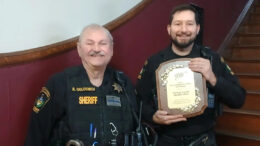By JUDITH O. ETZEL
Contributing writer
As the Venango Chamber Orchestra celebrates its 25th anniversary, it follows a long tradition of enduring and well-known musical troupes.
A live musical performance, one awash with fiddlers and horn players and drummers, was once a key ingredient in this area’s cultural heritage.
It was a symphonic history made possible by strong support, both in money and enthusiasm, in Oil City, Franklin and Titusville. Business and industry were healthy enough to stir up each of those communities and that, in turn, loaned credence to the arts, particularly music.
After World War I, the famous 112th Infantry Orchestra, named the “best orchestra in the American Expeditionary Forces,” began staging concerts in the Oil City and Franklin areas, home to most of the musicians.
In the 1920s and into the ’30s, area movie theaters signed on orchestras and small ensembles to play for nightly film showings. The opulent Drake and the Latonia theaters in Oil City became important sources of income for musicians. Radio stations, too, hired musicians. WLBW Radio Station upstairs in the Drake building in Oil City boasted an orchestral ensemble.
One of the most widely known musical groups in the late 1920s was the Inter-City Symphony Orchestra, composed of musicians from the tri-city area. Many of its members later regrouped and formed the Oil City Civic Orchestra in the late 1940s and early 1950s.
Many area churches, too, fielded their own orchestras. Among the better known were the Franklin First Baptist Church Sunday School Orchestra and the Oil City Good Hope Lutheran Church Orchestra.
High school music departments showcased their young instrumentalists with orchestras, a practice that ended in the 1980s.
The old orchestras
One of the best-known area symphonies came clad in Army cloth.
Conducted by Major “Maj” D. Olmes Sr., an Oil City East End native, the group was known as “the best orchestra in the American Expeditionary Forces” in World War I.
At the end of hostilities, the 112th orchestra, whose members served as stretcher-bearers in combat areas, competed against eight other military bands in La Mans, France. The local musicians won a gold medal and a trip to Monte Carlo.
Olmes and several fellow musicians, most of them World War I veterans, later organized the Inter-City Symphony Orchestra and it became widely known and recognized. Considered a highly professional orchestra, it was in existence from 1926 through 1931.
In 1947, the Oil City Civic Orchestra, again under the leadership of Olmes, organized and began holding rehearsals on Sunday afternoons in the second floor auditorium of the Oil City Library.
On April 6 of that year, Easter Sunday, the 55-member orchestra presented its first public concert.
The free public performance, sponsored by the Oil City Knights of Columbus and the Oil City Elks Lodge, was held at 3 p.m. in the K. of C. hall before more than 600 people.
Within a year, the group changed its name to the Oil City-Franklin Civic Orchestra to reflect its twin city membership. On Dec. 3, 1948, the orchestra traveled to Franklin High School and presented a concert featuring classical, ballet, light opera and popular selections to 450 patrons in the auditorium.
In each case, wrote a newspaper reporter, “the audience showed its appreciation by its prolonged applause accorded each selection and the orchestra was obliged to respond with several encores.”
The Civic Orchestra was versatile, offering classical selections by Mozart, Liszt, Brahms and others as well as more contemporary pieces by Cole Porter and George Gershwin. The violin section at 15 instruments was the largest in the orchestra, complete with violas, cellos, bass violas, harp, bassoon, flutes, clarinets, horns, trumpets, trombones, tuba, tympani and drums.
Several members of the Civic Orchestra, which stayed active through the early 1950s, continued to play in subsequent groups such as the Venango Chamber Orchestra, the Franklin Cornet Band and Oil City’s Mostly Brass band.
There were numerous smaller orchestras, too, throughout the Oil Valley, and they regularly were booked into Pittsburgh hotels, East Coast resorts, movie and performing arts theaters, private clubs and public concerts.
Among them in the 1920s, ’30s and ’40s were the Ted Williamson Orchestra (also known as the Silver Stream Band), the Merle Keyes Orchestra, George Castle and his Castle Nova Orchestra, Curley Williams and his Orchestra, Fred Ingraham’s Orchestra, Major Olmes and His Regiment of Rhythm, and the Jerry Chic Orchestra.





























